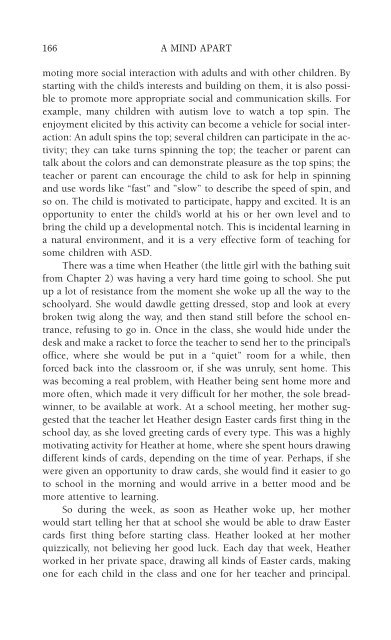978-1572305441
autism
autism
Create successful ePaper yourself
Turn your PDF publications into a flip-book with our unique Google optimized e-Paper software.
166 A MIND APART<br />
moting more social interaction with adults and with other children. By<br />
starting with the child’s interests and building on them, it is also possible<br />
to promote more appropriate social and communication skills. For<br />
example, many children with autism love to watch a top spin. The<br />
enjoyment elicited by this activity can become a vehicle for social interaction:<br />
An adult spins the top; several children can participate in the activity;<br />
they can take turns spinning the top; the teacher or parent can<br />
talk about the colors and can demonstrate pleasure as the top spins; the<br />
teacher or parent can encourage the child to ask for help in spinning<br />
and use words like “fast” and ”slow” to describe the speed of spin, and<br />
so on. The child is motivated to participate, happy and excited. It is an<br />
opportunity to enter the child’s world at his or her own level and to<br />
bring the child up a developmental notch. This is incidental learning in<br />
a natural environment, and it is a very effective form of teaching for<br />
some children with ASD.<br />
There was a time when Heather (the little girl with the bathing suit<br />
from Chapter 2) was having a very hard time going to school. She put<br />
up a lot of resistance from the moment she woke up all the way to the<br />
schoolyard. She would dawdle getting dressed, stop and look at every<br />
broken twig along the way, and then stand still before the school entrance,<br />
refusing to go in. Once in the class, she would hide under the<br />
desk and make a racket to force the teacher to send her to the principal’s<br />
office, where she would be put in a “quiet” room for a while, then<br />
forced back into the classroom or, if she was unruly, sent home. This<br />
was becoming a real problem, with Heather being sent home more and<br />
more often, which made it very difficult for her mother, the sole breadwinner,<br />
to be available at work. At a school meeting, her mother suggested<br />
that the teacher let Heather design Easter cards first thing in the<br />
school day, as she loved greeting cards of every type. This was a highly<br />
motivating activity for Heather at home, where she spent hours drawing<br />
different kinds of cards, depending on the time of year. Perhaps, if she<br />
were given an opportunity to draw cards, she would find it easier to go<br />
to school in the morning and would arrive in a better mood and be<br />
more attentive to learning.<br />
So during the week, as soon as Heather woke up, her mother<br />
would start telling her that at school she would be able to draw Easter<br />
cards first thing before starting class. Heather looked at her mother<br />
quizzically, not believing her good luck. Each day that week, Heather<br />
worked in her private space, drawing all kinds of Easter cards, making<br />
one for each child in the class and one for her teacher and principal.



